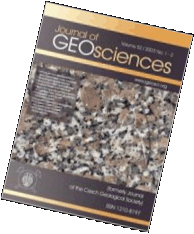 Export to Mendeley
Export to MendeleyOriginal paper
Bismuth, lead-bismuth and lead-antimony sulfosalts from the granite-hosted hydrothermal quartz veins at the Elisabeth mine, Gemerská Poloma, Spišsko-gemerské rudohorie Mts., Slovakia
Journal of Geosciences, volume 66 (2021), issue 3, 157 - 173
DOI: http://doi.org/10.3190/jgeosci.328
An interesting assemblage of bismuth and complex lead-bismuth and lead-antimony sulfosalts have been identified in samples from hydrothermal quartz veins hosted in S-type granitic rocks at the Elisabeth mine near Gemerská Poloma, Slovakia. We provide the first detailed study of the chemical composition of sulfosalts from the hydrothermal veins directly related to the specialized (Sn-W-F enriched) Gemeric granites. Bismuthinite derivates (bismuthinite and phases with naik ranging from 21.3 to 23.7 and 30.3), minerals of the kobellite-tintinaite series (with Sb/(Sb+Bi) atomic ratio ranging considerably between 0.13 and 0.71), giessenite-izoklakeite series (with Sb/(Sb+Bi) from 0.26 to 0.33) as well as Pb-Sb sulfosalts (mainly jamesonite, boulangerite, robinsonite and their Bi-rich varieties) are common. Rare Bi-enriched rouxelite, bournonite and minerals of the tetrahedrite group were also observed. The two distinct types of sulfosalts associations were distinguished, each related to the different type of host rock and with variable Bi/Sb ratio. The first is represented predominantly by Bi-rich sulfosalts (bismuthinite derivates, kobellite, giessenite-izoklakeite) and occurs in the quartz veins hosted in P-enriched leucogranite. The second association is developed only in hydrothermal quartz veins hosted in porphyric granites and except of Bi (bismuthinite derivates) also significant amounts of Sb-rich sulfosalts (tintinaite, boulangerite, robinsonite, jamesonite, rouxelite, bournonite and tetrahedrite-(Zn) to tetrahedrite-(Fe)) are present.
Webdesign inspired by aTeo. Hosted at the server of the Institute of Petrology and Structural Geology, Charles University, Prague.
ISSN: 1803-1943 (online), 1802-6222 (print)
email: jgeosci(at)jgeosci.org


IF (WoS, 2023): 1.1
5 YEAR IF (WoS, 2023): 1.5
Policy: Open Access
ISSN: 1802-6222
E-ISSN: 1803-1943